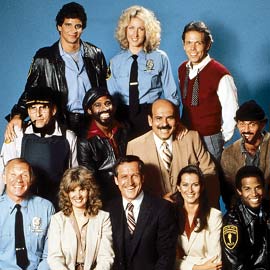 This past weekend, I finished binge watching the first season of “L.A. Law” on DVD. I hadn’t seen any of these episodes in nearly 30 years but the memories of them came flooding back quickly. Character names and plot lines popped back into my head much more quickly than I would have anticipated. And I loved every second of it!
This past weekend, I finished binge watching the first season of “L.A. Law” on DVD. I hadn’t seen any of these episodes in nearly 30 years but the memories of them came flooding back quickly. Character names and plot lines popped back into my head much more quickly than I would have anticipated. And I loved every second of it!
But more than just memories of the show returned; so did memories of the mid- to late-80s. I found myself thinking about where I was in life at that time (18 years old and a college freshman) and what was going on in my life. I thought about fashions, music, friends, pop culture, politics, etc., of that time.
“L.A. Law” truly reflected its time period. But there was another very different show that did the same for the early 1980s: “Hill Street Blues.”
 “Hill Street Blues” and “L.A. Law” were the first two of three dramas that would help NBC dominate Thursday nights for more than two decades (the third? “E.R.,” which launched in 1994, the same year “L.A. Law” ended). And they both came from the same creator, Steven Bochco.
“Hill Street Blues” and “L.A. Law” were the first two of three dramas that would help NBC dominate Thursday nights for more than two decades (the third? “E.R.,” which launched in 1994, the same year “L.A. Law” ended). And they both came from the same creator, Steven Bochco.
Both shows had incredible writing that mixed interpersonal drama with larger social issues. Both shows would often turn quickly from drama to comedy and back again. Both had incredible ensemble casts. And both were honored with multiple Emmy wins.
But there was another similarity to both shows: they were reflections of the two halves of the 1980s.
“Hill Street Blues” debuted in early 1981 and dominated television into the mid-1980s. Set in an inner city police station, it was dark and gritty. It focused on the over worked and under-supported police officers of the Hill Street station and their daily encounters with rampant crime and violence. Injury, death, and emotional trauma were common occurrences. It was a show that focused on the poor and the working class.
In the early 1980s, the United States was facing the worst economic times it had seen since the Great Depression with unemployment over 10 percent and crime, particularly violent crime, skyrocketing to new levels. Americans felt uneasy about their financial security and threatened by this wave of violence. And “Hill Street Blues” perfectly reflected the fears and uncertainties of the working classes.
“L.A. Law” was very different. And it came about in a different time. By 1986, the United States was seeing a return to economic strength. The Yuppies had begun their rise to prominence and excess in all forms was the new norm.
Set in a downtown Los Angeles law firm, “L.A. Law” focused on the upper middle class and the wealthy. While many of the cases they dealt with involved crime and poverty, the main characters were clearly well-to-do, dressed well, and lived well with fancy cars and large houses. Among the cases dealing with social issues like women’s rights, gay rights, and AIDS, were multi-million dollar business deals, extravagant divorce proceedings, and tax issues for wealthy clients. It fed into the American appetite at the time for excess and glamour and escapism.
“Hill Street Blues” and “L.A. Law” overlapped for one season, 1986-1987. “L.A. Law” took over the Thursday night time slot that “Hill Street” had held for so long. And “Hill Street” moved to Tuesday night to finish its seventh and final season. “Law” would come to an end with its eighth season in 1994.
While both shows were highly successful, they are largely forgotten today. The lack of syndicated reruns or availability on DVD (two seasons of “Hill Street” and one season of “Law” on Netflix) or streaming (Only three seasons of “Hill Street” are available on Hulu; I haven’t found “L.A. Law” streaming anywhere. And I’ve looked!) probably contributes to that.
But they’re still worth watching today. They are not only high quality shows, they are perfect time capsules of the two very different halves of the 1980s. If you lived through it, it’s fun and nostalgic to revisit that time. And, if you weren’t there or weren’t old enough to remember, it’s a real education.
